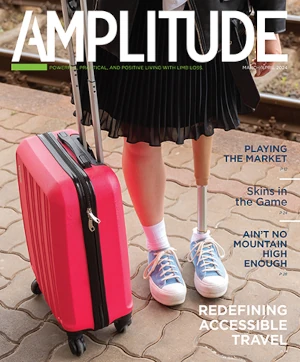
Pixelated electronics built with skin-like materials conform to the complex curves of a hand.
Image by L.A. Cicero courtesy of Stanford University.
Restoring lost sense of touch with stretchable, electronically-sensitive synthetic materials has been the focus of research conducted by Stanford University chemical engineer Zhenan Bao, PhD for more than 20 years. In research published February 19 in the journal Nature, Bao and a team of researchers described their development of stretchable, touch-sensitive circuitry and a mass-production manufacturing process for it. The new polymer circuitry with integrated touch sensors may one day lead to coverings for prosthetic devices that have skin-like sensitivity.
The research describes the two technical firsts: the material’s ability to detect the light pressure of an artificial ladybug footprint and the method to mass produce the new class of flexible, stretchable electronics—a critical step on the path to commercialization, Bao said.
“Research into synthetic skin and flexible electronics has come a long way, but until now no one had demonstrated a process to reliably manufacture stretchable circuits,” she said.
Bao’s hope is that manufacturers might one day be able to make sheets of polymer-based electronics embedded with a broad variety of sensors, and eventually connect these flexible, multipurpose circuits with a person’s nervous system. Such a product would be similar to human skin, a more complex biochemical sensory network. Before it leads to artificial skin, the process will enable the creation of foldable, stretchable touchscreens, electronic clothing, or skin-like patches for medical applications.
Bao said their production process involves several layers of new polymers, some that provide the material’s elasticity and others with intricately patterned electronic
meshes. Other layers serve as insulators to isolate the electronically sensitive material. One step in the production process involves the use of an inkjet printer to paint on certain layers.
The research team has successfully fashioned its material in squares about two inches on a side and containing more than 6,000 individual signal-processing devices that act like synthetic nerve endings. All this is encapsulated in a waterproof protective layer.
The prototype can be stretched to double its original dimensions while maintaining its ability to conduct electricity without cracks, delamination, or wrinkles and return to its original size and shape. To test durability, the team stretched a sample more than one thousand times without significant damage or loss of sensitivity. The sample was also tested while adhered to a human hand.
Bao said much work lies ahead before the new materials and processes are as ubiquitous and capable as rigid silicon circuitry. First, she said, her team must improve the electronic speed and performance of their prototype but calls this development a promising step.
“I believe we’re on the verge of a whole new world of electronics,” she said.
Editor’s note: This story was adapted from materials provided by Stanford University.



